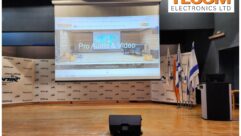
AV Motivates Students on Year-round School Calendar
Jul 2, 2008 12:00 PM,
By Linda Seid Frembes

Now that it’s July, there is no doubt that summer has arrived. Thoughts of school are far behind most teachers and students; but for a select group, the change in temperature doesn’t mean time off from the classroom. According to the National Association for Year-Round Education (NAYRE), nearly 400 school districts in 44 states ran on a year-round program during the 2006-2007 school year.
Rather than having two semester blocks with breaks during the holidays and over the summer, schools on a year-round calendar focus on continuous learning. According to NAYRE, that translates into shorter and more frequent breaks to minimize what educators call “learning loss” that occurs over a long period out of the classroom.
The challenge for educators is to keep kids interested in learning, with an approach similar to a marathon rather than a sprint. To that end, schools turn to AV technology to help inspire and foster creativity. “Students are much more engaged when technology is involved. It is much more exciting when I can enhance or enrich a lesson with a video than just reading a book or talking about a subject,” says Chance Hastings, a second-grade teacher in Castle Rock, Colo. Hastings teaches at one of the 23 Douglas County elementary schools that operate on a year-round calendar. “Students can also explore a wider knowledge base with a video as opposed to being limited to what I know about a topic. They also take much more ownership in their learning when they make a digital project.”
Douglas County is the third-largest school district in Colorado, and according to the school district’s website, it is one of the highest performing in the state. Hastings’ classroom includes a technology cart with an Apple MacBook computer, Logitech R-10 loudspeakers, a Epson Power Life 83+ LCD projector, an AverMedia Technologies AverVision 300AFP portable digital document, a video iPod with speaker dock, and a Nikon CoolPix.L11 digital camera.
In addition to United Streaming by Discovery Education , Hastings uses Apple’s iLife software to construct projects for her classroom. “I record the class singing in Garage Band, or a script I have written over content in Garage Band, export it to iTunes, pull it into iMovie, and match it up with pictures my students have made in Kid Pix or video I have edited from United Streaming. I have also imported Comic Life into iDVD to enrich projects,” she says. “I like how user-friendly United Streaming is and how quickly I can search for content by grade level.”
1
AV Motivates Students on Year-round School Calendar
Jul 2, 2008 12:00 PM,
By Linda Seid Frembes
With so many options, choosing the appropriate video for use with the curriculum can be a challenge. “I search by subject and grade level. From there, I watch several videos and decide which ones are developmentally appropriate and which ones align with the curriculum the best. Second-graders usually respond well to music, so if the video has a way of incorporating music into learning, I will select that one,” says Hastings, who has more than four years of experience incorporating AV into her classroom.
Students also get involved in using the classroom AV via class projects such as book talks (what previous generations may remember as a book report). “A book talk is a summary of a book that students individually record in Apple iMovie software using the computer’s built-in iSight camera,” Hastings says. “We also Skype with other classrooms in the building to have in-depth discussions where students ask and answer questions about a book both classes have read aloud.”
And for those of us who think assembling a Microsoft PowerPoint presentation is the pinnacle of technology skills, Hastings says, “Technology is changing even faster today. My second-graders are taking digital pictures, uploading them, and turning them into PowerPoint presentations. We need to prepare our students to keep up with this rapidly changing technological global society. We need to expose our kids to basic computer literacy skills from the primary grades and build from their technical problem solving skills as they get older.”
Hastings recently attended a workshop about using multi-tiered assessment tools. “You can design a system where students are given individualized tests and anonymously click in answers with a handheld remote,” she says. “As educators, we need to stay trained and proficient in the latest and greatest technology, so we can make it a daily integration into our classrooms. In this day and age, the technology should go above and beyond word processing. Technology should aid our students’ independence to access knowledge and increase their ability to communicate.”
2










